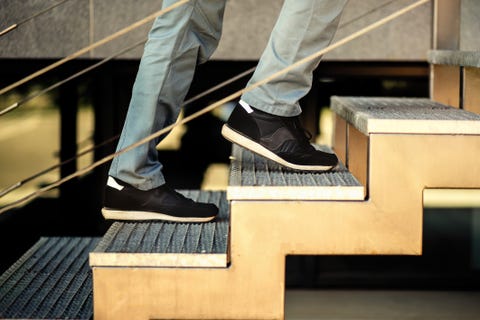8 Reasons Your Ankles are Weirdly Swollen

Sometimes you look down and all of a sudden you have a little bulge where your ankle bone used to be. Other times, swollen ankles make you feel as though there’s a chain around that joint.
There are several reasons why your ankles and feet might swell. Some are linked to medical conditions, others are sports- or lifestyle-related. In the case of the latter, you can help decrease the swelling with a few lifestyle tweaks. But if you can’t figure out pretty quickly what’s causing them, it’s worth a trip to a doctor to find out if there’s something bigger going on inside your body—like heart disease or hypertension—that could be the culprit and can be attended to.
Here’s a rundown of some of the main reasons you might have swollen ankles, plus a few tips for dealing with them.
1) You’re ankle is swollen because you’re injured
Any injury to a tendon, muscle, ligament, or bone can cause inflammation around the injured area, which leads to swelling. “This type of swelling can present with a bruise along the affected area and can occur minutes or even hours after injury,” says podiatrist Dana Canuso, MD.
2) It’s the end of the day
At the end of a full day of walking and sitting, gravity has been consistently trying to pull fluid down to your ankles and feet. So they might be more swollen than when you first woke up. “Our muscles and veins constantly have to work against gravity to filter the fluid up to our heart, but if there is an imbalance and gravity wins, you see that characteristic end-of-day swelling,” says Dr. Canuso.
If you know you will be on your feet for a long, long time in a day, you might consider wearing looser or more comfortable shoes so you’re prepared for your feet and ankles to expand and not hurt you by evening. And take breaks to sit down or elevate your feet and legs when you have a bit of downtime to break up the day.
“At the end of the day, elevating feet can help resist gravity and bring the fluid up to where it needs to go. And if you’re sitting at work all day, frequent short walks will activate your leg muscles and push the fluid up out of your legs,” says Dr. Canuso. Walking is the single best way to decrease feet and ankle swelling, she says. Bonus move: When you stand up, take a moment to do calf raises (just raise up on your toes and lower back down), which activate the leg muscles and help your limbs process the fluid.
3) Your ankles are puffy because you’ve been working out
Runners often complain of swelling in particular. “One of the drawbacks of long-distance running is that it tends to cause extra swelling in the lower extremities,” says podiatrist Velimir Petkov, DPM.

.
Subscribe to Men’s Health
Hearst Magazines
amazon.com
$5.00
Subscribe Now
“If you can imagine your legs as a pendulum when you exercise, especially while running, centripetal force is working on your feet and ankles. Over long runs, this force can be greater than the ability of your muscles and veins to move the fluid towards your heart, which causes the fluid to sit at the end of your legs,” says Dr. Canuso.
Bike riding for extended periods of time can also cause swelling, too. “The way you are seated on a bike can slightly compress the lymph nodes in your abdomen and groin keeping them from effectively processing fluid,” she explains.
If you have issues with ankle swelling when exercising, wearing compression socks and compression workout clothing may be helpful. “These add pressure to the outside of the leg, ankles, and feet helping to keep the fluid from entering the interstitial space and aiding in effectively pushing it up to the heart,” Dr. Canuso says.
Consider buying different shoes as well. “My recommendation is to buy sneakers or running shoes in the afternoon, preferably after a run, because that is when your feet and ankles tend to be the most swollen,” says Dr. Petkov.
4) Your diet is high in sodium
“A diet high in salt can cause uniform swelling throughout the body, especially in the feet and ankles,” says Dr. Cansuo. This swelling normally resolves quickly if your diet is modified. Reducing dietary salt intake will decrease the amount of water your body retains. Season your food with spices and herbs instead of salt and cook at home with whole foods when possible—restaurant food and processed foods tend to be high in sodium. (The DASH diet is notoriously good at being tasty without sodium.)
5) You have lymphedema
“Damage to the lymph system or nodes can occur with cancer, surgery, severe trauma or infection,” Dr. Canuso says, and it can worsen over time. This can cause lymphedema, a condition in which your body is not able to process the excess fluid, so it builds up in the interstitial space in your legs, ankles and feet. You definitely need see a doctor for assistance in management with this.
6) You have a blood clot, or DVT
“Swelling that occurs with blood clots has a very characteristic red and painful presentation. Deep venous thrombosis, or DVT’s, are a sudden onset of pain and swelling caused by a blood clot,” Dr. Canuso says. DVTs usually come on suddenly—they’re also linked to sitting for a long time without moving in a tight airplane row—and the limb can be red and extremely painful. If you even remotely think you have this, get to a doctor right away. The clot can travel to the lungs and be fatal.
7) Your medications are making your ankles swell
Certain medications, especially blood pressure drugs, diabetes meds, and steroids can cause swollen ankles and feet (find out more about swollen feet here). If you just started taking a medication and are plagued by swollen ankles, ask your pharmacist and doctor if your medication could be the cause.

Ekaterina BudinovskayaGetty Images
8) You have high blood pressure
“High blood pressure tends to be the result of kidney insufficiency,” Dr. Petkov says. The kidneys can’t help the body excrete extra fluid, and the fluid tends to accumulate mainly in the lower extremities. Over time, this can lead to venous insufficiency—the pathological process in which the vein valves become increasingly incompetent. If you have high blood pressure, you should be seeing a doctor for management, anyway; be sure to bring up the ankle swelling. A different medication or better control over your blood pressure may help.
Certain types of uncontrolled heart disease can make ankles swell as well. When your heart isn’t working well, it can’t pump blood back to the heart from the extremities as efficiently, and it can pool around the ankles. If you have swollen ankles and can’t figure out why, it’s worth a trip to the doctor.
Are some people more prone to having ankle swelling?
“People with jobs with little variation in movement which can include sitting all day or standing all day are more prone to swelling,” says Dr. Canuso.
And you might be more at risk if you’re very active or have a history of hypertension or chronic venous insufficiency, says Dr. Petkov. Another factor that leads to a higher likelihood of ankle swelling: Belly fat. This places extra pressure on the lymph nodes of the groin.
How to ease ankle swelling
In addition to specific tips based on your specific problem, the advice is this: Stay moving, keep sodium low, put your feet up, and consider taking an Epsom salts bath, says Dr. Petkov. “Soaking your feet and ankles in lukewarm water and Epsom salts is proven to reduce swelling.”
Source: Read Full Article




